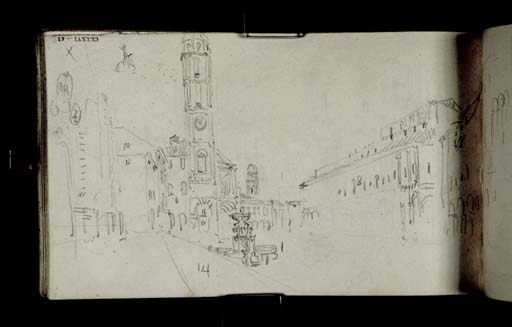Joseph Mallord William Turner Faenza: The Piazza del Popolo and Piazza della Libertà, with the Steps of the Cathedral, Clock Tower, Fountain and Town Hall 1819
Image 1 of 2
-
 Joseph Mallord William Turner, Faenza: The Piazza del Popolo and Piazza della Libertà, with the Steps of the Cathedral, Clock Tower, Fountain and Town Hall 1819
Joseph Mallord William Turner, Faenza: The Piazza del Popolo and Piazza della Libertà, with the Steps of the Cathedral, Clock Tower, Fountain and Town Hall 1819 -
 Joseph Mallord William Turner, Faenza: The Piazza del Popolo and Piazza della Libertà, with the Steps of the Cathedral, Clock Tower, Fountain and Town Hall 1819 (Enhanced image)Enhanced image
Joseph Mallord William Turner, Faenza: The Piazza del Popolo and Piazza della Libertà, with the Steps of the Cathedral, Clock Tower, Fountain and Town Hall 1819 (Enhanced image)Enhanced image
Joseph Mallord William Turner,
Faenza: The Piazza del Popolo and Piazza della Libertà, with the Steps of the Cathedral, Clock Tower, Fountain and Town Hall
1819
Joseph Mallord William Turner 1775–1851
Folio 47 Recto:
Faenza: The Piazza del Popolo and Piazza della Libertà, with the Steps of the Cathedral, Clock Tower, Fountain and Town Hall 1819
D14574
Turner Bequest CLXXVI 43
Turner Bequest CLXXVI 43
Pencil on white wove paper, 111 x 184 mm
Inscribed by Turner in pencil ‘14’ towards bottom left and ‘23’ right of centre, on colonnade, and the same number crossed out centre right on another building
Inscribed by John Ruskin in red ink ‘43’ top left, upside down (now faint)
Stamped in black ‘CLXXVI – 43’ top left, upside down
Inscribed by Turner in pencil ‘14’ towards bottom left and ‘23’ right of centre, on colonnade, and the same number crossed out centre right on another building
Inscribed by John Ruskin in red ink ‘43’ top left, upside down (now faint)
Stamped in black ‘CLXXVI – 43’ top left, upside down
Accepted by the nation as part of the Turner Bequest 1856
References
1909
A.J. Finberg, A Complete Inventory of the Drawings of the Turner Bequest, London 1909, vol.I, p.518, CLXXVI 43, as ‘Bridge with tower; also a piazza with fountain and church (Probably Cesena)’.
1984
Cecilia Powell, ‘Turner on Classic Ground: His Visits to Central and Southern Italy and Related Paintings and Drawings’, unpublished Ph.D thesis, Courtauld Institute of Art, University of London 1984, pp.83, 89–90, 406, as ‘Piazza del Popolo and Piazza della Libertà, Faenza, with the steps of the cathedral, the clock tower, fountain and town hall’, pp.463 note 70, 465 note 98, pl.20, as ‘The cathedral, clock tower, fountain and town hall, Faenza’.
1987
Cecilia Powell, Turner in the South: Rome, Naples, Florence, New Haven and London 1987, p.25, pl.18, as ‘Faenza: the cathedral, clock tower, fountain and town hall’.
2008
James Hamilton, ‘Turner e l’Italia’ in Hamilton, Nicola Moorby, Christopher Baker and others, Turner e l’Italia, exhibition catalogue, Palazzo dei Diamanti, Ferrara 2008, p.44, fig.25 (colour), as ‘Faenza. Piazza del Popolo e piazza della Libertà con i gradini della Cattedrale, la Torre dell’Orologio, la Fontana e il municipio’.
2009
James Hamilton, ‘Turner’s Route to Rome’ in Hamilton, Nicola Moorby, Christopher Baker and others, Turner & Italy, exhibition catalogue, National Galleries of Scotland, Edinburgh 2009, p.42, pl.43 (colour), as ‘Piazza del Popolo, Faenza, with the Steps of the Cathedral and Fountain’.
The view, south down the Piazza della Libertà, appears little changed today, with the unadorned west front of the cathedral above a flight of steps on the left and an elaborate fountain beyond. The Piazza del Popolo follows on to the right of the Palazzo del Podesta’s tall campanile-clock tower (with the dome of its cupola, cut off at the top of the page, as a separate detail to the left); the tower was destroyed in 1944 and rebuilt in 1953.3 Turner absent-mindedly initially wrote ‘23’ on the buildings in the right foreground, but crossed this figure out and wrote it instead on the next range to indicate the number of bays in the two-storey arcade and loggia of the Town Hall. As Powell has wondered: ‘Of the thousands of travellers that have journeyed towards Rome, how many, one might ask, have, like Turner, bothered to count the number of steps leading up to the cathedral at Faenza or the bays of its town hall?’4
Powell has commented on the relatively uneventful phase of Turner’s journey between leaving Bologna and reaching Rimini (folios 43 recto–60 verso; D14566–D14598; Turner Bequest CLXXVI 39a–56a);5 James Hamilton has noted this as one of the more detailed views en route, ‘suggesting he spent more time’ here than in some places sketched hurriedly on adjacent pages.
For Turner’s overall route south-east between Bologna and Ancona, see the sketchbook’s Introduction.
Matthew Imms
March 2017
See ‘Torre dell’Orologio (Torre Civica)’, Pro Loco Faenza, accessed 6 January 2017, http://www.prolocofaenza.it/it/visita-faenza/luoghi/chiese-e-monumenti/torre-dell-orologio-torre-civica/ .
How to cite
Matthew Imms, ‘Faenza: The Piazza del Popolo and Piazza della Libertà, with the Steps of the Cathedral, Clock Tower, Fountain and Town Hall 1819 by Joseph Mallord William Turner’, catalogue entry, March 2017, in David Blayney Brown (ed.), J.M.W. Turner: Sketchbooks, Drawings and Watercolours, Tate Research Publication, July 2017, https://www

